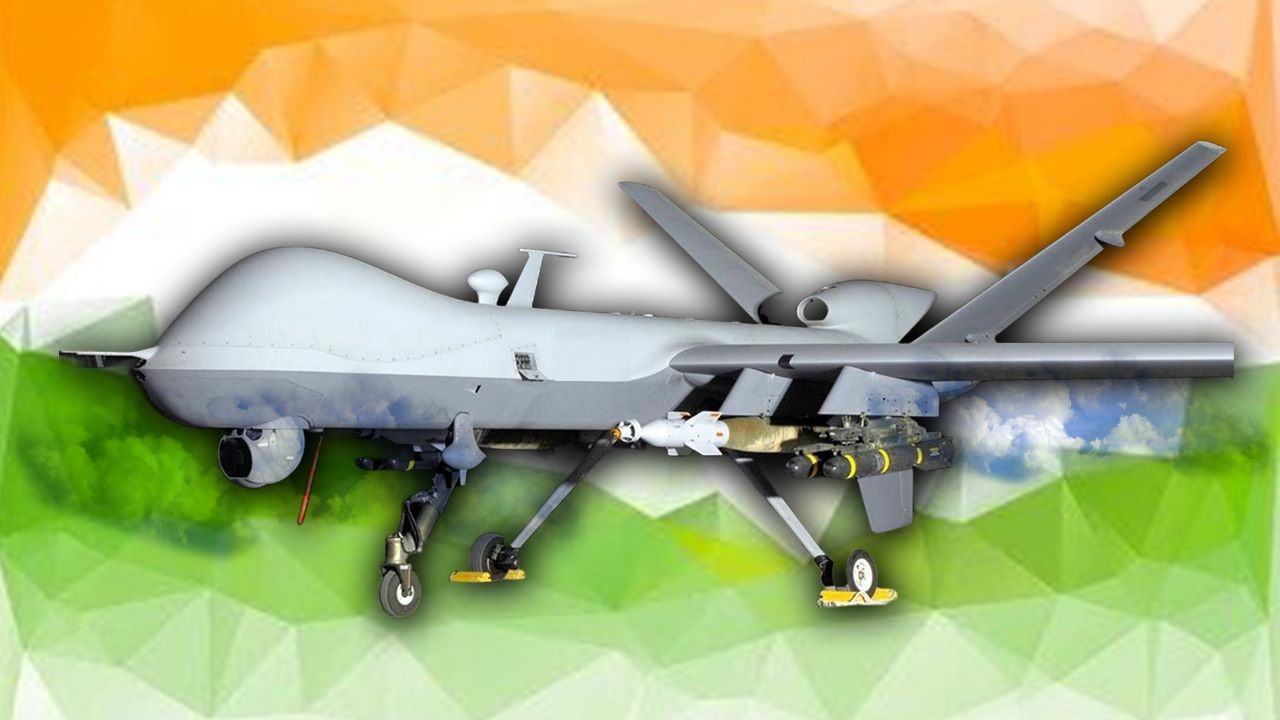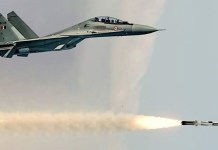The United States has notified its Congress of a possible sale of 31 MQ-9B Sky Guardian drones, capable of being armed for anti-surface and anti-submarine missions, to India, along with a slew of weapons and sensors, all worth US$4 billion.
In a statement on the notification, the United States Defense Security Cooperation Agency (DSCA) stated the platform transfer would improve India’s capability “to meet current and future threats by enabling unmanned surveillance and reconnaissance patrols in sea lanes of operation.”
The notification came much to the chagrin of naysayers in India, who were fibbing over supposed opposition in the US Congressional Foreign Affairs Committee from Indian-origin Congress members to the Sky Guardian sale to India.
The media report, just ahead of the Congressional notification, quoted unnamed US-based sources to claim the opposition to the sale was over allegations of an assassination attempt on an American citizen of Indian origin, who campaigns for the dismemberment of India and has been designated as a terrorist by New Delhi.
“The State Department has made a determination approving a possible Foreign Military Sale to the Government of India of MQ-9B Remotely Piloted Aircraft and related equipment for an estimated cost of $3.99 billion. The Defense Security Cooperation Agency delivered the required certification notifying Congress of this possible sale today,” a statement from Washington on February 1 said.
India had requested to buy 31 MQ-9B Sky Guardian aircraft, 15 of which would go to the Indian Navy, and the remaining 16 would be split equally by the Indian Army and the Indian Air Force, according to previous reports.
India Also Needs Weapons, Sensors
The Indian request also included 161 Embedded Global Positioning & Inertial Navigation Systems (EGIs); 35 L3 Rio Grande Communications Intelligence Sensor Suites; 170 AGM-114R Hellfire missiles; 16 M36E9 Hellfire Captive Air Training Missiles (CATM); 310 GBU-39B/B Laser Small Diameter Bombs (LSDB); and eight GBU-39B/B LSDB Guided Test Vehicles (GTVs) with live fuzes.
It also included Certifiable Ground Control Stations; TPE-331-10-GD engines; M299 Hellfire missile launchers; KIV-77 cryptographic appliques and other Identification Friend or Foe (IFF) equipment; KOR-24A Small Tactical Terminals (STT); AN/SSQ-62F, AN/SSQ-53G, and AN/SSQ-36 sonobuoys.
Further, the US$3.99 billion package would include ADU-891/E Adapter Group Test Sets; Common Munitions Built-In-Test (BIT) Reprogramming Equipment (CMBRE); GBU-39B/B tactical training rounds, Weapons Load Crew Trainers, and Reliability Assessment Vehicles-Instrumented; Portable Pre-flight/Post-flight Equipment (P3E); CCM-700A encryption devices; KY-100M Narrowband/wideband terminals; KI-133 cryptographic units; AN/PYQ-10 Simple Key Loaders; Automatic Identification System (AIS) transponders; ROVER 6Si and TNR2x transceivers; MR6000 ultra high frequency (UHF) and very high frequency (VHF) radios; Selex SeaSpray Active Electronically Scanned Array (AESA) surveillance radars; and HISAR-300 Radars.
Moreover, India would get SNC 4500 Auto Electronic Surveillance Measures (ESM) Systems; SAGE 750 ESM systems; Due Regard Radars (DRR); MX-20 Electro-Optical Infrared (EO-IR) Laser Target Designators (LTDs); Ku-Band SATCOM GAASI Transportable Earth Stations (GATES); C-Band Line-of-Sight (LOS) Ground Data Terminals; AN/DPX-7 IFF transponders; Compact Multi-band Data Links (CMDL); initial spare and repair parts, consumables, accessories, and repair and return support; secure communications, precision navigation, and cryptographic equipment.
The US would also deliver, under this sale, munitions support and equipment; testing and integration support and equipment; classified and unclassified software delivery and support; classified and unclassified publications and technical documentation; personnel training and training equipment; transportation support; warranties; studies and surveys; US Government and contractor engineering, technical, and logistics support services; and other related elements of logistics and program support.
Sale Meets US Foreign Policy Objectives
“This proposed sale will support the foreign policy and national security objectives of the United States by helping to strengthen the US-India strategic relationship and to improve the security of a major defense partner, which continues to be an important force for political stability, peace, and economic progress in the Indo-Pacific and South Asia region,” the statement on the DSCA website said.
“The proposed sale will improve India’s capability to meet current and future threats by enabling unmanned surveillance and reconnaissance patrols in sea lanes of operation. India has demonstrated a commitment to modernizing its military and will have no difficulty absorbing these articles and services into its armed forces.” It added that the proposed sale of this equipment and support will not alter the basic military balance in the region.
General Atomics Aeronautical Systems will be the principal contractor for the delivery of the Sky Guardian drones, and this deal would likely come with offsets clause, an agreement towards which would be defined in price negotiations and other details of the contract. “Implementation of this proposed sale will not require the assignment of any additional US Government or contractor representatives to India. There will be no adverse impact on US defense readiness as a result of this proposed sale,” DSCA said.
It has taken India and the US at least a decade to reach this stage when the sale of the Sky Guardian drones is now a sure shot. After dilly-dallying over the high cost of the procurement of American drones, India whittled down its requirement to just 31 Sky Guardians. But ahead of this, India leased two Sea Guardian drones for its navy in 2020 to carry out surveillance and deployed the system for patrols in the Ladakh region against China’s aggression that began in May 2020.
What Are Sky Guardians?
According to the General Atomics Aeronautical website, the MQ-9B SkyGuardian is the next generation of remotely piloted aircraft systems, delivering persistent intelligence, surveillance, and reconnaissance (ISR) around the globe. SkyGuardian is designed to fly over the horizon via satellite for up to 40+ hours in all types of weather and safely integrate into civil airspace, enabling joint forces and civil authorities to deliver real-time situational awareness anywhere in the world—day or night.
The aircraft is outfitted with the revolutionary Lynx Multi-mode Radar, an advanced electro-optical/infrared (EO/IR) sensor, automatic takeoff and landing, and a longer wingspan than its predecessors at 79 ft (24m). In addition to its endurance and surveillance capabilities, SkyGuardian seamlessly integrates with its users’ other platforms, systems, and podded technologies, dramatically expanding the platform’s multi-domain mission sets.
SkyGuardian can be configured to conduct several ISR operations, including but not limited to Humanitarian Assistance/Disaster Relief, Search and Rescue, Law Enforcement, Border Enforcement, Defensive Counter Air, Airborne Early Warning, Electronic Warfare, Anti-Surface Warfare (with mission kit), Anti-Submarine Warfare (with mission kit), Airborne Mine Counter Measures (with mission kit), Long-Range Strategic ISR, and Over-the-Horizon Targeting.

SkyGuardian is derived from a family of systems that have achieved over 8 million flight hours over the past decade, supporting operations around the globe, from the battlefield to environmental and humanitarian efforts. Based on this experience, SkyGuardian provides enhanced payload capacity and an open architecture system enabling the aircraft to integrate the most advanced sensor payloads for intelligence gathering, survivability, and even kinetic payloads for more complex operational environments, the General Atomics description said.
SkyGuardian features nine hardpoints (8 wings, one centerline) with a max 4750 lb (2155 kg) external payload capacity. This enables armed forces and governments to easily integrate sovereign payloads and mission systems for their own uniquely tailored solutions. India becomes the second nation to have this platform after the UK’s Royal Air Force, which has redesignated the Sky Guardians as Protector RG Mk1.
Is It Worth The Money?
In July 2019, the Hindustan Times reported that the Indian Military reconsidered acquiring the Reaper drones due to high costs and wanted to focus on other critical needs.
As per reports, the IAF had internally raised questions about an armed drone surviving in highly contested airspace near Pakistan and China, with both foes armed with lethal surface-to-air missile (SAM) systems.
“The other significant reason behind the Indian rethink is the prohibitive price of armed drones like the Predator-B. According to the military establishment, the cost of a bare drone platform will be to the tune of $100 million, and a full complement of weapons like laser-guided bombs or hell-fire missiles will cost another $100 million,” said a senior South Block official.
“Under the circumstances, the IAF will give preference to acquiring more multi-role fighters with long-range air-to-air missiles, and the Indian army will be looking towards replacing its dated T-72 tanks. The Indian navy needs more surface combatants at sea rather than an armed drone for projecting itself as an Indo-Pacific power.”
Indian veteran fighter pilot and prominent defense commentator Vijainder K Thakur asks how many times we have heard top Air Force officials publicly acknowledge the fall in the number of fighter jet squadrons. And how many times have we heard them complain about the non-availability of UAVs like Reapers?
You can read his analysis here, why MQ-9s don’t make sense for India.
Thakur believes drones like the MQ-9 Reaper are suited to low-intensity, asymmetric conflicts, but a clash with China or Pakistan will neither be low-intensity nor asymmetric.
Meanwhile, India is paying a whopping $99 million for each MQ-9B drone. Thakur shares that the unit cost of other aerial platforms that India could have bought instead:
- Rafale – $98 million
- F-35 – $89.2 million
- Su-30MKI – $42 million
- Heron-2 Drone – $ 6 to $10 million
- The projected cost of the Su-75 Checkmate stealth fighter is $30 million
Not everyone agrees with Thakur. Vice Admiral Shekhar Sinha (retired) earlier told the EurAsian Times that any frontline fighter jets would have to refuel multiple times in a single mission, but Reaper can enter those long flights and free up fighters for other jobs more suited to their flight range. You can read the entire analysis here.
- Penned By EurAsian Times Desk
- Follow EurAsian Times On Twitter
- Follow EurAsian Times on Google News




